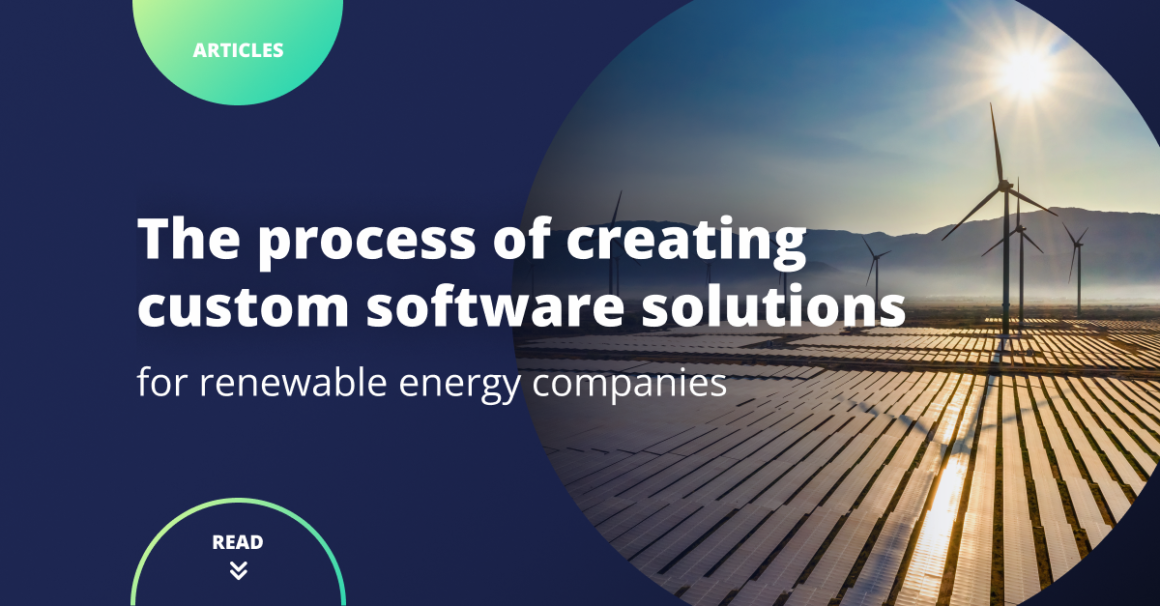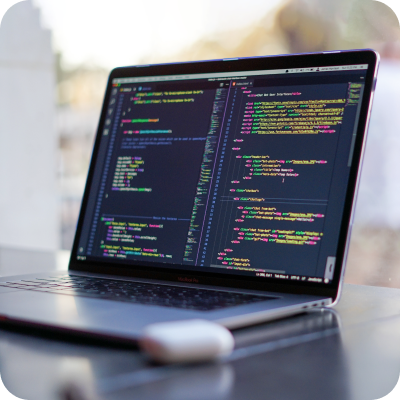The process of creating custom software solutions for renewable energy companies

Getting a custom software solution for a renewable energy company has multiple benefits. You get a platform that has precisely the features or integrations your organization needs, is seamlessly integrated into the main infrastructure, plus it can grow together with your company. In addition, they can basically give you the level of customization that off-the-shelf software can’t – simply because the latter is made for a “general audience,” while custom software is designed for your and only your company.
Building bespoke software in-house can be a pretty intimidating task though, so many brands decide to rely on third-party software development company for the job. When they see how much time, effort, and budget is required to build software from scratch, they get concerned though.
Why does it take even up to a year to develop custom software?
To answer the question, we’ll show you now step by step how we at Codibly work on custom software solutions – and what you can expect when you decide to work with us on your own custom software project.
8 main stages of the custom software development process

One of the best benefits of getting off-the-shelf solutions for managing your renewable energy business is that you can start using it almost immediately. Cloud platforms make it even easier as you don’t have to go through a lengthy installation either – you just need to create an account, pay for the license and then configure the system.
This might be an ideal option for those who want to start using a platform immediately.
With custom development though, the situation is drastically different. Between the first meeting with the custom software development companies and getting a ready product, it might take from 4 months to even over a year, depending on how complex the entire project will be.
What exactly takes the development team so much time?
Let’s take a closer look at all the stages involved in custom software development.
Introduction meeting
If you have an idea for a custom platform that could help your renewable energy company work more efficiently, but you don’t have the time to skills or time to handle the development project yourself, we’ll gladly lend you a hand here. Once you reach out to us via the Request form on our page, we’ll schedule an introduction meeting, during which we’ll talk with you about the business requirements and main reasons why you need a custom software for your renewable energy brand.
During the meetings, we’ll also invite you to a 2-day Discovery Workshops meeting during which we’ll research the development requirements in more detail.
Gathering the requirements during Discovery Workshops
To ensure that the new custom software will meet all your business needs, we’ll next set up a few meetings as part of the Discovery stage. During those meetings, we’ll want to learn more about:
- The current state of your company and business processes
- The main issues or challenges you are facing and want to solve through the custom development
- Features, integrations, and any specific capabilities you need for the new platform
- Your existing infrastructure, software used, and any technical requirements for the new system
- and a few other questions, depending on the project type.
This might seem like a lot of questions, but this is all so we could better understand your expectations for the new software and then pick the right developers, technologies, and tech stack for the project. We’ll also use the workshops to briefly introduce you to the agile development methodology we are using for the projects and to set up how and how often we’ll communicate with you.
Estimating the time and budget needed
Once we have all the project details noted down, we’ll estimate how long the development project will take and how much the project will cost, down to describing the time and cost of each subtask. The project manager will then send you detailed information with:
- Software requirement specification document
- Suggested project team members
- Estimated project scope and planned features for the new software solution
- Resources and technologies we’ll be using
- Project timeline, milestones list, and deadlines.
Once you have approved the budget and the project plan, we’ll create the necessary documents for you to sign, and then we will be ready to start the project ball rolling.

UI/UX design
Once the legal requirements are all handled, we can start working on building your dream custom software. We’ll start with creating the designs, business logic, and user flows and then turn those into wireframes for the new software.
Of course, we’ll call you a few times to discuss the designs too, making sure everything is just as you wanted.
Proof of Concept/Prototype/Minimum Viable Product development
Before we start with the main development phase, we’ll recommend designing a Proof of Concept (PoC in short) draft or building a Prototype or Minimum Viable version of the new software first. Why?
- PoC can help you examine the general product idea, see whether the features will work as intended, and let developers spot potential development problems. We typically finish a PoC stage in around 2 months.
- A prototype will let you see how a ready product will look, work and feel like, allow you to test the main features, and also let you add any changes to the designs as you need.
- MVP version is a functional version of a product with only the essential features included so you can test out the product in practice and then share your opinion on what should be improved/changed. We typically deliver a ready MVP product stage in around 3 months, though this depends on the project.
You might worry now that adding those stages will only make the project even longer, but that couldn’t be further from the truth – building a prototype or MVP version can actually save plenty of time (and a good part of the budget) later on.
For example, imagine that we started building the new software, but midway through the project, you realized you needed a few other features that weren’t included in the earlier plan. Or that you decided that you need those features after you have worked with the new software for some time. Adding those to the ready software would take time though, as some parts of the products might need to be rewritten to fit the new functionality. And that, unfortunately, would mean extra costs on your side.
Prototypes or MVP applications can be adjusted as needed until you are happy with the outcome. Plus, an MVP version also lets us spot issues that will be easy to fix at this stage – but would be far more time-consuming to solve during the actual development stages.
Development
Once you accept the designs and the development plan, our backend and frontend developers will start turning the designs and requirements into a ready product. The entire development phase will be divided into sprints, so we can give you precise information on what tasks are completed and what we are currently working on and also to quickly respond to any project suggestions you might have.
We’ll also keep sending you regular reports on how the project is progressing and, if you want, also invite you to team meetings.
Quality Assurance and Testing
Each feature we’ll add to the new software will be tested through unit tests (to see are the individual modules are working as supposed to) and integration tests (to see if there are any problems when the modules are working together) plus they will be reviewed at the end of each sprint.
Our Quality Assurance specialists will also monitor the project to ensure that the ready software will meet quality standards and comply with renewable industry or other required regulations.
After the development stage is finished, we’ll run thorough testing on the ready product as well to ensure you’ll get a high-quality product that is as bug-free as possible.

Implementation and post-launch support
Once the software passes quality assurance and testing, it will be handed to you. That’s not the end of our cooperation though – we’ll help you install and configure the new solutions for renewable energy and also train your staff on how to use it. Our team will also take care of regular maintenance, bug, or vulnerabilities and fix and updating the system to match your company’s changing requirements.
How can Codibly help you with developing custom software for your renewable business?
During 11 years of working with companies from the renewable industry, we’ve helped multiple brands get tailor-fit software for their needs. For example, one of the companies we worked with is Nordex Group – one of the world’s largest wind turbine manufacturing companies.
As they are providing their services in over 25 markets, they needed a single management platform that could integrate all their distributed applications for monitoring the conditions of their wind warms.
For this task, our software developers created a Control Center Platform, an all-in-one software that provides the company with a 360-degree overview of its entire fleet: 8000 wind farms, 200 000 wind turbines, and 2 000 000 devices.
Through the platform, the company can also:
- Monitor, manage, analyze, plan, and predict every aspect of their entire wind fleet
- Put on hold wind turbines in a given location straight from the application, depending on the data coming from the forecasting and reporting tools
- Monitor the state of their equipment in real-time and identify potential faults early, which allows them to fix them in advance and avoid equipment failure
- Automate the process of error tracking, fixing, and reporting through a specialized business rules engine
In the same way we Nordex Group, we can help your business as well – so feel free to send us your brief if you are looking for someone with experience in designing custom solutions for the renewable energy industry.
Conclusion
Custom software development is an excellent way for businesses to solve their internal problems, have the features they need to run their business efficiently, and ensure that the software will be useful for them for years to come.
As custom development can be quite complex though (especially for newer industries like renewable energy), it might be a good option to reach out to development companies specializing in creating software for this industry.
At Codibly, we built custom software applications for multiple brands from the renewable sector – so we’ll surely know how to design a system that will give you a competitive edge. And with the step-by-step development process we described above, you should now see what you can expect from working with us – and we’ll be glad to show you our skills in practice.
contact us
Need expert guidance on your next energy project?
Reach out to us and discover how Codibly can offer tailored solutions to drive your business.